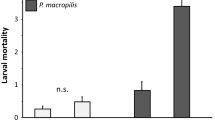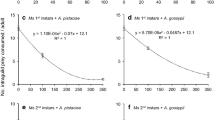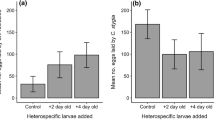Abstract
Intraguild predation (IGP) is common in most communities, but many aspects of density-dependent interactions of IG predators with IG prey are poorly resolved. Here, we examine how the density of an IG predator can affect feeding group size, IG egg predation, and the growth responses of IG prey. We used laboratory feeding trials and outdoor mesocosm experiments to study interactions between a social intraguild predator (larvae of the wood frog; Rana sylvatica) and its prey (spotted salamander; Ambystoma maculatum). Larvae of R. sylvatica could potentially affect A. maculatum by consuming shared larval food resources or by consuming eggs and hatchlings. However, successful egg predation requires group feeding by schooling tadpoles. We established from five to 1,190 hatchlings of R. sylvatica in mesocosms, then added either 20 A. maculatum hatchlings to study interspecific competition, or a single egg mass to examine IGP. Crowding strongly suppressed the growth of R. sylvatica, and IGP was restricted to the egg stage. In the larval competition experiment, growth of A. maculatum was inversely proportional to R. sylvatica density. In the predation experiment, embryonic mortality of A. maculatum was directly proportional to the initial density of R. sylvatica and the mean number of tadpoles foraging on egg masses. IGP on eggs reduced A. maculatum hatchling density, which accelerated larval growth. Surprisingly, the density of R. sylvatica had no overall effect on A. maculatum growth because release from intraspecific competition via egg predation was balanced by increased interspecific competition. Our results demonstrate that the density of a social IG predator can strongly influence the nature and intensity of interactions with a second guild member by simultaneously altering the intensity of IGP and intra- and interspecific competition.






Similar content being viewed by others
References
Arim M, Marquet PA (2004) Intraguild predation: a widespread interaction related to species biology. Ecol Lett 7:557–564
Baldwin RF, Calhoun AJK (2002) Ambystoma laterale (blue-spotted salamander) and Ambystoma maculatum (spotted salamander). Predation. Herpetol Rev 33:44–45
Balfour RA, Buddle CM, Rypstra AL, Walker SE, Marshall SD (2003) Ontogenetic shifts in competitive interactions and intra-guild predation between two wolf spider species. Ecol Entomol 28:25–30
Bednekoff PA, Lima SL (2004) Risk allocation and competition in foraging groups: reversed effects of competition if group size varies under risk of predation. Proc R Soc Lond B 271:1491–1496
Biesterfeldt JM, Petranka JW, Sherbondy S (1993) Prevalence of chemical interference competition in natural populations of wood frogs, Rana sylvatica. Copeia 1993:688–695
Borer ET, Briggs CJ, Murdoch WW, Swarbrick SL (2003) Testing intraguild predation theory in a field system: does numerical dominance shift along a gradient of productivity? Ecol Lett 6:929–935
Burgio G, Santi F, Maini S (2002) On intra-guild predation and cannibalism in Harmonia axyridis (Pallas) and Adalia bipunctata L. (Coleoptera: Coccinellidae). Biol Contr 24:110–116
Crumrine PW, Crowley PH (2003) Partitioning components of risk reduction in a dragonfly-fish intraguild predation system. Ecology 84:1588–1597
Denno RF, Fagan WF (2003) Might nitrogen limitation promote omnivory among carvivorous arthropods? Ecology 84:2522–2531
Denno RF, Gratton C, Peterson MA, Langellotto GA, Finke DL, Huberty AF (2002) Bottom-up forces mediate natural-enemy impact in a phytophagous insect community. Ecology 83:1443–1458
De Clercq P, Peeters I, Vergauwe G, Thas O (2003) Interactions between Podisus maculiventris and Harmonia axyridis, two predators used in augmentative biological control in greenhouse crops. BioControl 48: 39–55
Diehl S (2003) The evolution and maintenance of omnivory: dynamic constraints and the role of food quality. Ecology 84:2557–2567
Duellman WE, Trueb L (1986) Biology of amphibians. McGraw-Hill, New York
Felix S, Soares AO (2004) Intraguild predation between the aphidophagous ladybird beetles Harmonia axyridis and Coccinella undecimpunctata L. (Coleoptera: Coccinellidae): the role of the body weight. Eur J Entomol 101:237–242
Götmark F, Winkler DW, Andersson M (1986) Flock-feeding on fish schools increases individual success in gulls. Nature 319:589–591
Hairston NG Sr (1989) Ecological experiments: purpose, design, and execution. Cambridge University Press, New York
Hart DR (2002) Intraguild predation, invertebrate predators, and trophic cascades in lake food webs. J Theor Biol 218:111–128
Holbrook CT, Petranka JW (2004) Ecological interactions between Rana sylvatica and Ambystoma maculatum: a generalist tadpole organizes vernal pond community. Copeia 2004:932–939
Matsumura MG, Trafelet-Smith M, Gratton C, Finke DL, Fagan WF, Denno RF (2004) Does intraguild predation enhance predator performance? A stoichiometric perspective. Ecology 85:2601–2615
Newman RA (1994) Effects of changing density and food level on metamorphosis of a desert amphibian, Scaphiopus couchii. Ecology 75:1085–1096
Okuyama T, Ruyle RL (2003) Analysis of adaptive foraging in an intraguild predation system. Web Ecol 4:1–6
Petranka JW, Kennedy CA (1999) Pond tadpoles with generalized morphology: is it time to reconsider their functional roles in aquatic communities? Oecologia 120:621–631
Petranka JW, Rushlow AW, Hopey ME (1998) Predation by tadpoles of Rana sylvatica on embryos of Ambystoma maculatum: implications of ecological role reversals by Rana (predator) and Ambystoma (prey). Herpetologica 54:1–13
Pitcher TJ, Parrish JK (1993) Functions of shoaling behaviour in teleosts. In: Pitcher TJ (ed) Behaviour of teleost fishes. Chapman & Hall, London, pp 363–439
Polis GA, Myers CA, Holt RD (1989) The ecology and evolution of intraguild predation: potential competitors that eat each other. Annu Rev Ecol Syst 20:297–330
Polis GA, Holt RD (1992) Intraguild predation: the dynamics of complex trophic interactions. Trends Ecol Evol 7:151–154
Rosenheim JA, Corbett A (2003) Omnivory and the indeterminacy of predator function: can a knowledge of foraging behavior help? Ecology 84:2538–2548
Santi F, Burgio G, Maini S (2003) Intra-guild predation and cannibalism of Harmonia axyridis and Adalia bipunctata in choice conditions. Bull Insectol 56:207–210
Smith DC (1983) Factors controlling tadpole populations of the chorus frog (Pseudacris triseriata) on Isle Royale, Michigan. Ecology 64:501–510
Stoks R, McPeek MA (2003) Predators and life histories shape Lestes damselfly assemblages along a freshwater habitat gradient. Ecology 84:1576–1587
Taniguchi Y, Fausch KD, Nakano S (2002) Size-structured interactions between native and introduced species: can intraguild predation facilitate invasion by stream salmonids? Biol Invasions 4:223–233
Walls SC, Williams MG (2001) The effect of community composition on persistence of prey with their predators in an assemblage of pond-breeding amphibians. Oecologia 128:124–141
Walzer A, Paulus HF, Schausberger P (2004) Ontogenetic shifts in intraguild predation on thrips by phytoseiid mites: the relevance of body size and diet specialization. Bull Entomol Res 94:577–584
Wellborn GA, Skelly DK, Werner EE (1996) Mechanisms creating community structure across a freshwater habitat gradient. Annu Rev Ecol Syst 27:337–363
Wilbur HM (1972) Competition, predation, and the structure of the Ambystoma-Rana sylvatica community. Ecology 53:3–21
Wilbur HM (1976) Density-dependent aspects of metamorphosis in Ambystoma and Rana sylvatica. Ecology 57:1289–1296
Wilbur HM, Collins JP (1973) Ecological aspects of amphibian metamorphosis. Science 182:1305–1314
Yurewicz KL (2004) A growth/mortality trade-off in larval salamanders and the coexistence of intraguild predators and prey. Oecologia 138:102–111
Acknowledgements
We thank S. Corkern, C. Etheredge, J. Hamel, T. Holbrook, J. Lloyd-Cowden, E. Richards, and G. Sours for field assistance and T. Forrest and C. Nicolay for their editorial assistance. We also thank two anonymous reviewers for constructive criticisms of the work. Collecting permit for Sandy Bottom, Buncombe County, was obtained from the North Carolina Chapter of the Nature Conservancy.
Author information
Authors and Affiliations
Corresponding author
Additional information
Communicated by Craig Osenberg
L . A. Burley and A. T. Moyer contributed equally to this work.
Rights and permissions
About this article
Cite this article
Burley, L.A., Moyer, A.T. & Petranka, J.W. Density of an intraguild predator mediates feeding group size, intraguild egg predation, and intra- and interspecific competition . Oecologia 148, 641–649 (2006). https://doi.org/10.1007/s00442-006-0398-z
Received:
Accepted:
Published:
Issue Date:
DOI: https://doi.org/10.1007/s00442-006-0398-z




